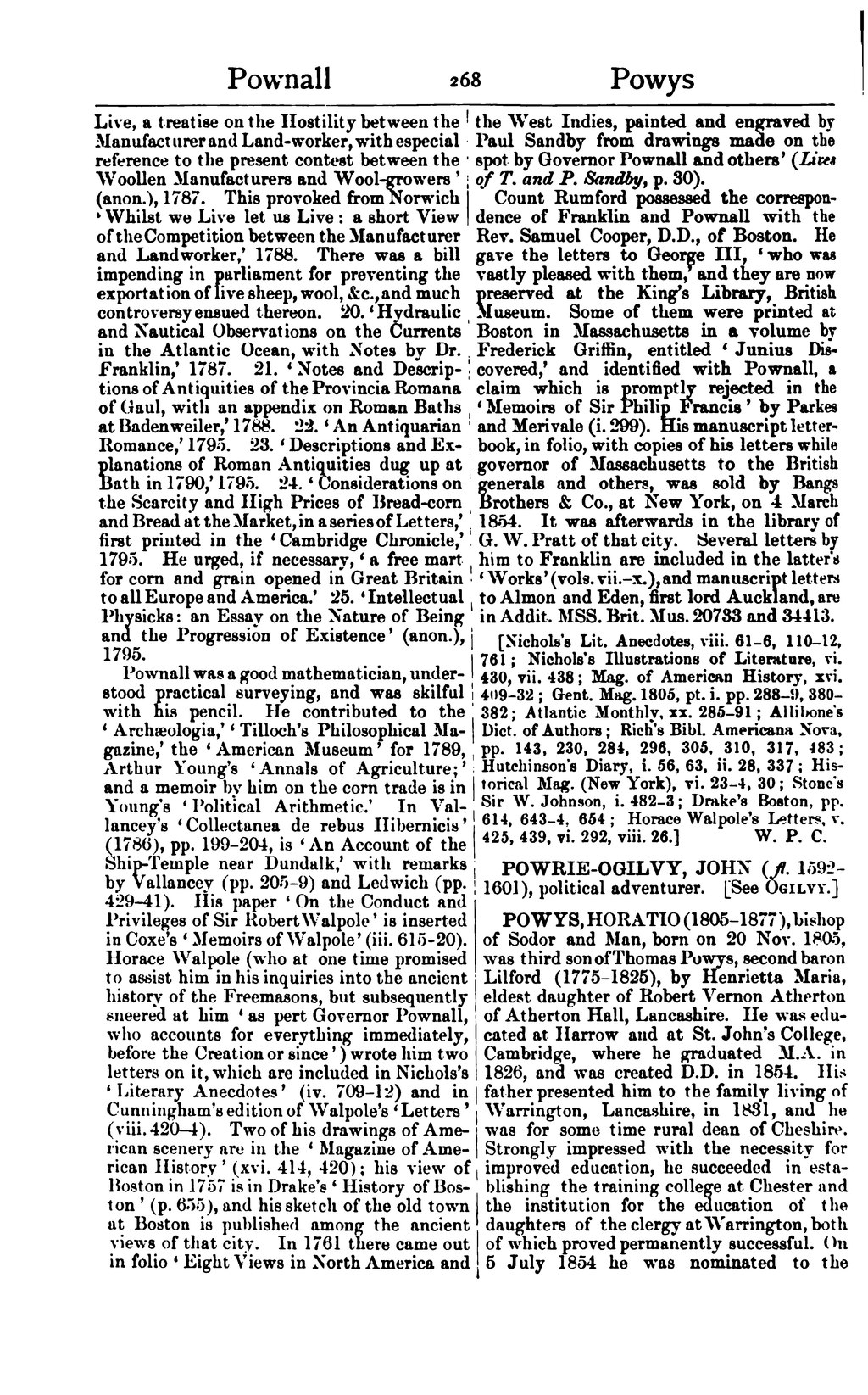Live, a treatise on the Hostility between the Manufacturer and Land-worker, with especial reference to the present contest between the Woollen Manufacturers and Wool-growers’ (anon.), 1787. This provoked from Norwich ‘Whilst we Live let us Live: a short View of the Competition between the Manufacturer and Landworker,’ 1788. There was a bill impending in parliament for preventing the exportation of live sheep, wool, &c., and much controversy ensued thereon. 20. ‘Hydraulic and Nautical Observations on the Currents in the Atlantic Ocean, with Notes by Dr. Franklin,’ 1787. 21. ‘Notes and Descriptions of Antiquities of the Provincia Romana of Gaul, with an appendix on Roman Baths at Badenweiler,’ 1788. 22. ‘An Antiquarian Romance,’ 1795. 23. ‘Descriptions and Explanations of Roman Antiquities dug up at Bath in 1790,’ 1795. 24. ‘Considerations on the Scarcity and High Prices of Bread-corn and Bread at the Market, in a series of Letters,’ first printed in the ‘Cambridge Chronicle,’ 1795. He urged, if necessary, ‘a free mart for corn and grain opened in Great Britain to all Europe and America.’ 25. ‘Intellectual Physicks: an Essay on the Nature of Being and the Progression of Existence’ (anon.), 1795.
Pownall was a good mathematician, understood practical surveying, and was skilful with his pencil. He contributed to the ‘Archæologia,’ ‘Tilloch's Philosophical Magazine,’ the ‘American Museum’ for 1789, Arthur Young's ‘Annals of Agriculture;’ and a memoir by him on the corn trade is in Young's ‘Political Arithmetic.’ In Vallancey's ‘Collectanea de rebus Hibernicis’ (1786), pp. 199–204, is ‘An Account of the Ship-Temple near Dundalk,’ with remarks by Vallancey (pp. 205–9) and Ledwich (pp. 429–41). His paper ‘On the Conduct and Privileges of Sir Robert Walpole’ is inserted in Coxe's ‘Memoirs of Walpole’ (iii. 615–20). Horace Walpole (who at one time promised to assist him in his inquiries into the ancient history of the Freemasons, but subsequently sneered at him ‘as pert Governor Pownall, who accounts for everything immediately, before the Creation or since’) wrote him two letters on it, which are included in Nichols's ‘Literary Anecdotes’ (iv. 709–12) and in Cunningham's edition of Walpole's ‘Letters’ (viii. 420–4). Two of his drawings of American scenery are in the ‘Magazine of American History’ (xvi. 414, 420); his view of Boston in 1757 is in Drake's ‘History of Boston’ (p. 655), and his sketch of the old town at Boston is published among the ancient views of that city. In 1761 there came out in folio ‘Eight Views in North America and the West Indies, painted and engraved by Paul Sandby from drawings made on the spot by Governor Pownall and others’ (Lives of T. and P. Sandby, p. 30). Count Rumford possessed the correspondence of Franklin and Pownall with the Rev. Samuel Cooper, D.D., of Boston. He gave the letters to George III, ‘who was vastly pleased with them,’ and they are now preserved at the King's Library, British Museum. Some were printed in Frederick Griffin's ‘Junius Discovered’ (Boston, Mass.), a claim to identify Junius with Pownall, which was rejected in Parkes and Merivale's ‘Memoirs of Sir Philip Francis’ (i. 299). His manuscript letter-book, in folio, with copies of his letters while governor to the British generals and others, was sold by Bangs Brothers & Co., at New York, on 4 March 1854. It afterwards belonged to G. W. Pratt of that city. Several letters to Franklin are in the latter's ‘Works’ (vols. vii.–x.), and letters to Almon and Eden, first lord Auckland, are in Addit. MSS. Brit. Mus. 20733 and 34413.
[Nichols's Lit. Anecdotes, viii. 61–6, 110–12, 761; Nichols's Illustrations of Literature, vi. 430, vii. 438; Mag. of American History, xvi. 409–32; Gent. Mag. 1805, pt. i. pp. 288–9, 380–382; Atlantic Monthly, xx. 285–91; Rich's Bibl. Americana Nova, pp. 143, 230, 284, 296, 305, 310, 317, 483; Hutchinson's Diary, i. 56, 63, ii. 28, 337; Historical Mag. (New York), vi. 23–4, 30; Stone's Sir W. Johnson, i. 482–3; Drake's Boston, pp. 614, 643–4, 654; Horace Walpole's Letters, v. 425, 439, vi. 292, viii. 26; Charles A. W. Pownall's Thomas Pownall, 1908, an elaborate biography which seeks anew to identify Junius with Pownall.]
POWRIE-OGILVY, JOHN (fl. 1592–1601), political adventurer. [See Ogilvy.]
POWYS, HORATIO (1805–1877), bishop of Sodor and Man, born on 20 Nov. 1805, was third son of Thomas Powys, second baron Lilford (1775–1825), by Henrietta Maria, eldest daughter of Robert Vernon Atherton of Atherton Hall, Lancashire. He was educated at Harrow and at St. John's College, Cambridge, where he graduated M.A. in 1826, and was created D.D. in 1854. His father presented him to the family living of Warrington, Lancashire, in 1831, and he was for some time rural dean of Cheshire. Strongly impressed with the necessity for improved education, he succeeded in establishing the training college at Chester and the institution for the education of the daughters of the clergy at Warrington, both of which proved permanently successful. On 5 July 1854 he was nominated to the
